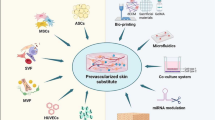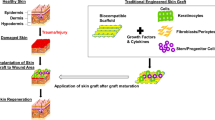Abstract
We developed a human skin equivalent (HSE) containing blood and lymph-like capillary networks using a cell-coating technique. This technique is a rapid fabrication technology of three-dimensional cellular constructs by cell surface coating using layer-by-layer assembled nanofilms of extracellular matrices. The thickness of a dermis consisting of normal human dermal fibroblast was easily controlled from approximately 5–100 μm by altering the seeded cell number. Keratinocytes as an epidermis showed homogeneous differentiation on the surface of the dermis by lifting to air-liquid interface, and immunological staining represented distinct four layers, stratum basale, spinosum, granulosum, and corneum. Interestingly, the measurement of transepithelial electrical resistance (TEER) indicated prolongation of the daily reached maximum value of TEER with an increase in the numbers of dermis layers. HSEs with six layers of dermis revealed the longest period maintained, over 500 Ω cm2 of TEER. The co-sandwich culture of human umbilical vein endothelial cells and normal human dermal lymphatic microvascular endothelial cells within an eight-layered dermis showed in vitro co-network formation of individual blood and lymph-like capillaries inside the dermis. This is the first report on homogeneous full-thickness HSEs with blood and lymph capillary networks that will be useful for biomedical and pharmaceutical applications.
Access this chapter
Tax calculation will be finalised at checkout
Purchases are for personal use only
Similar content being viewed by others

References
MacNeil S (2007) Progress and opportunities for tissue-engineered skin. Nature 445:874–880
Rheinwald JG, Green H (1975) Serial cultivation of strains of human epidermal keratinocytes: the formation of keratinizing colonies from single cells. Cell 6:331–344
Bell E, Ehrlich HP, Buttle DJ, Nakatsuji T (1981) Living tissue formed in vitro and accepted as skin-equivalent tissue of full thickness. Science 211:1052–1054
Eaglstein WH, Falanga V (1998) Tissue engineering and the development of Apligraf a human skin equivalent. Adv Wound Care 11:1–8
Yang L, Shirakata Y, Tokumaru S, **uju D, Tohyama M, Hanakawa Y et al (2009) Living skin equivalents constructed using human amnions as a matrix. J Dermatol Sci 56:188–195
Groeber F, Holeiter M, Hampel M, Hinderer S, Schenke-Layland K (2011) Skin tissue engineering–in vivo and in vitro applications. Adv Drug Deliv Rev 128:352–366
Sun T, Jackson S, Haycock JW, MacNeil S (2006) Culture of skin cells in 3D rather than 2D improves their ability to survive exposure to cytotoxic agents. J Biotechnol 122:372–381
Roguet R (1999) Use of skin cell cultures for in vitro assessment of corrosion and cutaneous irritancy. Cell Biol Toxicol 15:63–75
Ponec M (2002) Skin constructs for replacement of skin tissues for in vitro testing. Adv Drug Deliv Rev 54:S19–S30
Falanga V, Isaacs C, Paquette D, Downing G, Kouttabl N, Butmarc J et al (2002) Wounding of bioengineered skin: cellular and molecular aspects after injury. J Invest Dermatol 119:653–660
Lee DY, Cho KH (2005) The effects of epidermal keratinocytes and dermal fibroblasts on the formation of cutaneous basement membrane in three-dimensional culture systems. Arch Dermatol Res 296:296–302
Boehnke K, Mirancea N, Pavesio A, Eusenig NE, Boukamp P, Stark HJ (2007) Effects of fibroblasts and microenvironment on epidermal regeneration and tissue function in long-term skin equivalents. Eur J Cell Biol 86:731–746
Régnier M, Staquet MJ, Schmitt D, Schmidt R (1997) Investigation of Langerhans cells into a pigmented reconstructed human epidermis. J Invest Dermatol 109:510–512
Ouwehand K, Spiekstra SW, Saaijman T, Breetveld M, Scheper RJ, de Druijl TD et al (2012) CCL5 and CCl20 mediate immigration of Langerhans cells into epidermis of full thickness human skin equivalents. Eur J Cell Biol 91:765–773
Black AF, Berthod F, L’heureux N, Germain L, Auger FA (1998) In vitro reconstruction of a human capillary-like network in a tissue-engineered skin equivalent. FASEB J 12:1331–1340
Auxenfans C, Lequeux C, Perrusel E, Mojallal A, Kinikoglu B, Damour O (2012) Adipose-derived stem cells (ASCs) as a source of endothelial cells in the reconstruction of endothelialized skin equivalents. J Tissue Eng Regen Med 6:512–518
Yang L, Shirakata Y, Shudou M, Dai X, Tokumaru S, Hirakawa S et al (2006) New skin-equivalent model from de-epithelialized amnion membrane. Cell Tissue Res 326:69–77
Nishiguchi A, Yoshida H, Matsusaki M, Akashi M (2011) Rapid construction of three-dimensional multilayered tissue with endothelial tube networks by the cell-accumulation technique. Adv Mater 23:3506–3510
Decher G (1997) Fuzzy nanoassemblies: toward layered polymeric multicomposites. Science 277:1232–1237
Matsusaki M, Ajiro H, Kida T, Serizawa T, Akashi M (2012) Layer-by-layer assembly through weak interactions and their biomedical applications. Adv Mater 24:454–474
Matsusaki M, Kadowaki K, Nakahara Y, Akashi M (2007) Fabrication of cellular multilayers with nanometer-sized extracellular matrix films. Angew Chem Int Ed 46:4689–4692
Matsusaki M, Amemori S, Kaodwaki K, Akashi M (2011) Quantitative 3D analysis of nitric oxide diffusion in a 3D artery model using sensor particles. Angew Chem Int Ed 50:7557–7561
Matsusaki M (2012) Development of three-dimensional tissue models based on hierarchical cell manipulation using nanofilms. Bull Chem Soc Jpn 85:401–414
Shirakata Y, Ueno H, Hanakawa Y, Kameda K, Yamasaki K, Tokumaru S et al (2004) TGF-beta is not involved in early phase growth inhibition of keratinocytes by 1alpha,25 (OH) 2 vitamin D3. J Dermatol Sci 36:41–50
Shirakata Y, Tokumaru S, Yamasaki K, Sayama K, Hashimoto K (2003) So-called biological dressing effects of cultured epidermal sheets are mediated by the production of EGF family, TGF-beta and VEGF. J Dermatol Sci 32:209–215
Yang L, Shirakata Y, Tamai K, Dai X, Hanakawa Y, Tokumaru S et al (2005) Microbubble-enhanced ultrasound for gene transfer into living skin equivalents. J Dermatol Sci 40:105–114
Chetprayoon P, Kadowaki K, Matsusaki M, Akashi M (2013) Survival and structural evaluations of three—dimensional tissues fabricated by the hierarchical cell manipulation technique. Acta Biomater 9:4698–4706
Nishiguchi A, Matsusaki M, Asano Y, Shimoda H, Akashi M (2014) Effects of angiogenic factors and 3D-microenvironments on vascularization within sandwich cultures. Biomaterials 35:4739–4748
Wang X-N, McGovern N, Gunawan M, Richardson C, Windebank M, Siah T-W et al (2014) A three-dimensional atlas of human dermal leukocytes, lymphatics, and blood vessels. J Invest Dermatol 134:965–974
Hirakawa S, Brown LF, Kodama S, Paavonen K, Alitalo K, Detmar M (2007) VEGF-C-induced lymphangiogenesis in sentinel lymph nodes promotes tumor metastasis to distant sites. Blood 109:1010–1017
Kadowaki K, Matsusaki M, Akashi M (2010) Three-dimensional constructs induce high cellular activity: structural stability and the specific production of proteins and cytokines. Biochem Biophys Res Commun 402:153–157
Karaman S, Detmar M (2014) Mechanisms of lymphatic metastasis. J Clin Invest 124:922–928
Welner RS, Kincade PW (2007) Stem cell on patrol. Cell 131:842–844
Acknowledgments
This work was supported mainly by PRESTO-JST, and partly by a Grant-in-Aid for Scientific Research on Innovative Areas (21106514 and 26106717) from MEXT of Japan, The Noguchi Institute Fund, and by NEXT Program from JSPS (LR026).
Author information
Authors and Affiliations
Corresponding author
Editor information
Editors and Affiliations
Rights and permissions
Copyright information
© 2017 Springer Japan KK
About this chapter
Cite this chapter
Matsusaki, M., Fujimoto, K., Shirakata, Y., Hirakawa, S., Hashimoto, K., Akashi, M. (2017). Development of Full-Thickness Human Skin Equivalents with Blood and Lymph-like Capillary Networks by Cell Coating Technology. In: Sugibayashi, K. (eds) Skin Permeation and Disposition of Therapeutic and Cosmeceutical Compounds. Springer, Tokyo. https://doi.org/10.1007/978-4-431-56526-0_31
Download citation
DOI: https://doi.org/10.1007/978-4-431-56526-0_31
Published:
Publisher Name: Springer, Tokyo
Print ISBN: 978-4-431-56524-6
Online ISBN: 978-4-431-56526-0
eBook Packages: Biomedical and Life SciencesBiomedical and Life Sciences (R0)



